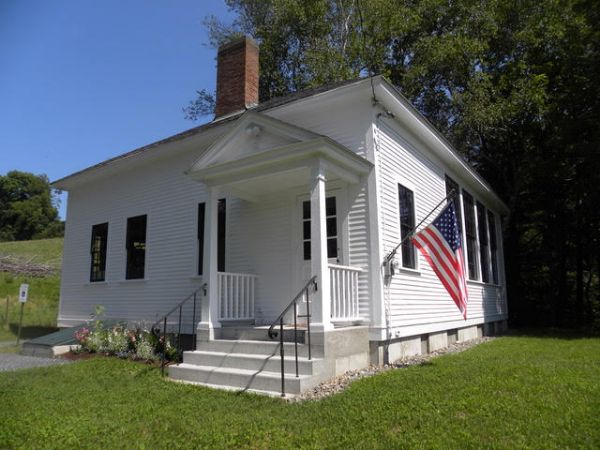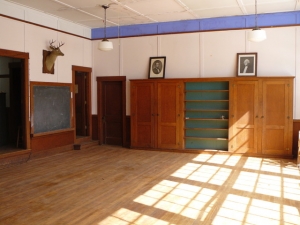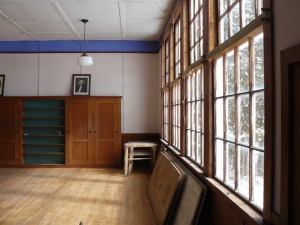
In 2013 both the Root Schoolhouse and the Beaver Meadow Schoolhouse were named to the National Register of Historic Places, a program of the National Park Service, signifying their importance as significant architectural and historic resources. Norwich’s well-known commitment to public education goes back centuries and has its roots in one-room schoolhouses such as these.
Vermont’s first public grammar school was established in Norwich in 1785. This schoolhouse was situated on the site of today’s Congregational Church. In the 1800s, Norwich had twenty schoolhouses; five were still operational as recently as 1940. The last rural schoolhouse closed in 1951, when it was decided that all Norwich children would attend the village school. Since the permanent closing of Norwich’s rural schoolhouses, most were sold to private owners or, sadly, deteriorated or were torn down. The two exceptions are the Beaver Meadow Schoolhouse, located on Chapel Hill Road, and the Root Schoolhouse located on Union Village Road at Goodrich Four Corners.
See link to Beaver Meadow Schoolhouse
See link to Root Schoolhouse
Root Schoolhouse
The Root Schoolhouse, located on Union Village Road near the intersection of Goodrich Four Corners Road, is one of the last two one-room schoolhouses in Norwich, Vermont. Built in 1937, this structure replaced a schoolhouse that had burned the year before. At the time, it was considered the only rural schoolhouse in Norwich to be in excellent condition, earning a “superior” rating from the state and additional praise from state education executives. Despite the new building’s quality, the Root Schoolhouse was closed in the fall of 1945, when enrollment had dwindled to only four pupils.
A 1952 agreement between the Norwich School Board and the Root District Game Club, a small organization of families surrounding the schoolhouse, transformed the building into a community center. Thanks to the stewardship of this small community for nearly sixty years, the Root Schoolhouse was available to the public, the site of many community meals, performances, and even wedding receptions.
Inevitably, perhaps, the growing list of the Schoolhouse’s maintenance needs began to exceed the resources of this small group of families living nearby, and the schoolhouse became unusable due to the deterioration of its foundation. This problem was first documented in a 2002 professional building assessment, which reported that the basement walls “if not replaced will eventually fail. The only solution is to either move the building or jack it up and replace the entire foundation.” Despite the Game Club’s efforts to raise money for repairs, the problem worsened over the next several years, and the Game Club ceased all activities at the schoolhouse in 2011.

A children’s dictionary has a definition of “support” that is perfectly suited to the Root District Schoolhouse: “to hold up in position by serving as a foundation or base for.” In more ways than one, Root Schoolhouse needed support from the bottom up. As the situation became apparent, both neighbors and others outside of the Root community became interested in saving this building and once again making it available for community events. A small group of citizens with a can-do attitude for this monumental task raised close to $200,000 from 200 donors and grantors to do just what was needed to save the building from the ravages of water and time. Not only was the foundation replaced, but also the windows were restored, the exterior scraped and painted, and a ramp was built for accessibility. In spring 2022 the chimney was repaired, a new roof applied, and the interior walls and ceiling repaired and painted. Contractors have taken an interest in its restoration and volunteers have shared their skills with fundraising, landscaping, historic preservation, outreach, and artistic talent.
 The Root Schoolhouse is now “open for business” for locally organized events and rentals as a community and educational center. This is an exciting story of resilience. The next chapter is yet to be written and may include more projects to make the building useful year-round, but for now the Game Club plans to make memberships available in order to help with the ongoing operating expenses.
The Root Schoolhouse is now “open for business” for locally organized events and rentals as a community and educational center. This is an exciting story of resilience. The next chapter is yet to be written and may include more projects to make the building useful year-round, but for now the Game Club plans to make memberships available in order to help with the ongoing operating expenses.
With the repurposing of this wonderful historic one-room schoolhouse, the community has contributed in re-imagining its use just as it was re-imagined in 1952. This is a unique venue which has drawn a lot of attention and has garnered noteworthy appeal from the community throughout the town of Norwich and the region. Less than a ten-minute drive from Dan & Whits on a main road, with a 600 square-foot room, a stage, and a separate kitchen, this building’s simple charm holds extraordinary potential.

Visit the website rootschoolhouse.org for more history and information about a documentary called Back to School: Lessons from Norwich’s One-Room Schoolhouses.
